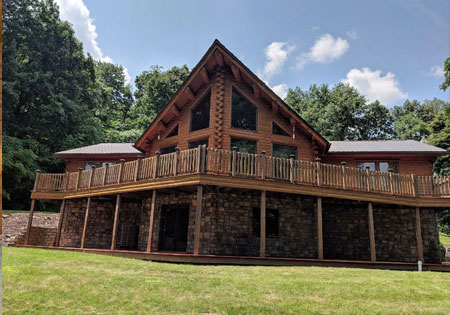Spring Check-Up
Posted by Ward Cedar Log Homes in Featured Home Care and Maintenance Log Homes
Ah, spring. It’s all about new beginnings, which means there’s no better time to give your log home a freshening up. Just like the interiors of your home get a boost from a spring cleaning, the exterior of your log, timber, or hybrid home benefit from a little extra attention, too.
Most homeowners admire the exterior of their homes often but from afar — say, when pulling up to the house or doing yard work — but performing an intentional visual inspection of your logs and timbers is important to keep them in tip-top condition. The warmer weather that spring brings makes it an ideal time to perform an annual once-over of your logs.
Here are three common log home threats to look out for (plus an action plan!) as you ready your log home for spring:
Check It Out: Surface Mold. Take a walk around the perimeter of your house and perform a visual inspection of your logs and timbers. Look for dark (black or green) areas on the wood. While this discoloration can occur anywhere, it is most often found on the north side of the home due to limited sun exposure. Mold and mildew aren’t a cause for panic, but they do require quick action to prevent the moisture from further penetrating the wood and causing long-term damage, like rot or decay. Keep in mind, even if no mold is visible, your log home will need to be pressure washed annually and recoated every few years.
Treat It Right: Begin by sanding down the affected logs, applying a borate treatment, then following up with a fresh coat of stain. It’s essential to look for a sealant that offers superior moisture and UV-ray protection. Our tried-and-true recommendation is Outlast Q8 Log Oil, a wood preservative that targets decay-causing organisms, like mold and termites. Once applied, there’s no need to strip before re-coating on the next go-round. Find more details here; call us at 800-341-1566 to order.
Check It Out: Cracks or Checks. The Ward Cedar way of using only air-dried cedar helps ensure there will be fewer checks in your logs. (The slower a log dries, the less prone it is to checking.) Still, logs will naturally weather over time, sometimes developing small cracks. This is all part of the rustic effect of a log home, but there are times when a check will require additional attention. If the checks are on the top side of the log (where rain naturally falls) or are wider than one-fourth of an inch, you’ll want to repair them now.
Treat It Right: Fill the gap with flexible backer rod, followed by Perma-Chink Energy Seal exterior caulking. Learn about Energy Seal; call us at 800-341-1566 to order.
Check It Out: Insect Holes. If you notice small holes in your wood, it’s a sure sign that carpenter bees (or other burrowing insects) have made their way into your logs. Carpenter bees are particularly egregious offenders, as they can make up to a four-foot tunnel in your logs before carving out a nest. Once the eggs hatch and mature, the bees will return to their home to continue the same process each year. Sawdust on your logs or pollen spots will also alert you to their tunnels.
Treat It Right: You can banish the bees once by treating the area with borax, but we recommend an additive known as NBS 30. It’s most effective when added to your stain, but it can also be used as an as-needed spot treatment by mixing it with water and applying directly to the insect holes. Keep in mind that using a stain with a polyurethane base can also help prevent them from burrowing, as can applying an insecticide around your cabin or home’s exterior. Learn about the stain and additive; call us at 800-341-1566 to order.


Post Your Comment